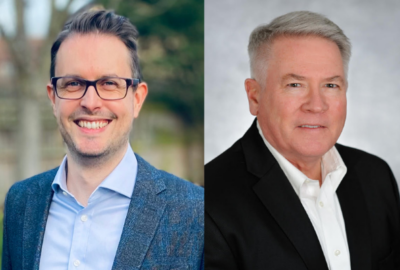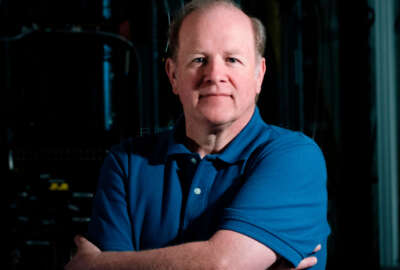A new federal effort to bolster the nation’s expertise in quantum computing
Two federal science agencies have together launched a plan to bolster U.S. strength in a field known as quantum information science and technology. The Office of...
Best listening experience is on Chrome, Firefox or Safari. Subscribe to Federal Drive’s daily audio interviews on Apple Podcasts or PodcastOne.
Two federal science agencies have together launched a plan to bolster U.S. strength in a field known as quantum information science and technology. The Office of Science and Technology Policy, part of the White House crew, and the National Science Foundation parted with a group called the National Q-12 Education Partnership to, as they put it, explore training and education opportunities in quantum. The Federal Drive with Tom Temin spoke with the National Science Foundation director, Dr. Sethuraman Panchanathan about what’s going on and why it’s important.
Interview transcript:
Tom Temin: This must be important if the director is taking a personal interest in this particular program. So tell us what is quantum, quantum computing and science and why does it matter so much?
Sethuraman Panchanathan: Thank you so much, Tom. We can look at quantum from different perspectives. For example, in physics, it means a smallest, non-divisible amount of a physical property, such as energy, for example. And at that scale, the rules of nature behave very differently from how they behave at the scale of you and me. From a policy perspective, education, popular science and technology, and others, quantum is more often used as a jargon for Quantum Information Science and Engineering, or referred to as few QISE, Sometimes also called QIST, the “T” is for technology. This use of quantum essentially clones a set of disciplines that are involved: physics, material science, chemistry, computer science, engineering, mathematics and so on. So in collaboration with industry, that you’re using unique properties that exist at a quantum scale, to develop practical applications, such as quantum computers, quantum sensors and quantum communication networks. In this context, you often hear about quantum education of quantum workforce as other variations on this theme.
Tom Temin: And this is a technology that China is pursuing. And when we get down to the level of quantum mechanics used in quantum calculation, what can it do that we can’t do now?
Sethuraman Panchanathan: The speed of computing that you can do, the speed at which you can do this, the scale at which you can do this, the energy consumption that goes with it, that is a much lower energy consumption, all of things make the future of computing exceedingly exciting. We can solve mega problems, huge problems, whether it is related in relation to climate, or predictive properties, like the prediction of a pandemic, for example. Working with the human genome data, and a whole host of things where you can actually process things at speed and at scale. And that’s what makes this very exciting. Clearly, there are many countries who are also pursuing the approaches to enhancing the capacities and capabilities and technologies in quantum, because it’s a leading edge technology, the future industry, if you want to look at it that way. We have to be in the vanguard of how we make sure that we are not only producing the research, the advanced research concepts, but also translating them into technologies, working with industry, but most importantly, training this diverse workforce that is capable of engaging in this new area, which is not just a disciplinary area, as I said earlier, it is an interdisciplinary area by bringing together multiple disciplines.
Tom Temin: Now you have several companies that have claimed they are at the quantum computing level and using the units of quantum computing that have come into the parlance. Google I think is one, maybe IBM is one, maybe Amazon is one. But it sounds like you’re talking to something larger than that, which is been hard to verify. So my question is, isn’t this what they’re teaching now anyway, in the computer science schools?
Sethuraman Panchanathan: So when you teach at a computer science school, I’m a computer scientist myself, you might see one facet of quantum computing, as it pertains to the computer science aspects of it. But when you want to sort of train people in the broadest sense of what quantum means, for example, a quantum engineer must know elements of coding, quantum mechanics, low temperature physics, material science and electronics in order to build and operate a computer. So as you can see, Tom, it requires training, which brings inspirations from multiple disciplines in training the quantum workforce of the future, and quantum researchers of the future. They may pursue research in a particular facet of it, but they need to have the broadest understanding of what it means to work in this area of quantum. So when you talk about the industry, therefore, they’re looking for such talent being generated at scale, so that we might be in the vanguard of competitiveness.
Tom Temin: We’re speaking with Dr. Sethuraman Panchanathan, director of the National Science Foundation. The difference here I guess, is in traditional computer science and electrical engineering, one can proceed relatively free of the other, because you can run something in a new programming language on old hardware. And new hardware can run software designed for an older piece of hardware. But in this case, it sounds like the nation needs a systems approach to getting to quantum.
Sethuraman Panchanathan: That’s an excellent way of saying it Tom, a systems approach. That’s exactly what it is. Right from determining the basic materials to the building of the devices. They’re building of the system, and programming of the system to do the things that you want it to do. All of this requires training and understanding at the scale that we need to, for example, the quantum workforce, we might need a diverse set of specialists. While they may have this broad set of training and specializations in certain aspects. For example, you could have qualified machinists, producing intricate parts to academic researchers exploring the theoretical limits of a quantum scale environment. So because the field is expanding rapidly, alongside swift technological progress in quantum computing and networking, the demand for qualified workers is increasing, as you talked about earlier, from industry.
But our schools may not always be ready to switch from a disciplinary training to the diverse, multidisciplinary one needed here. So industry, academia and governments alike are facing shortages of qualified people. Which means to every problem that is an opportunity, isn’t it Tom? Therefore, the shortage in the QISE workforce opens up opportunities for broadening participation, and including because we talk about diversity of discipline, so diversity of so many facets that can be brought to this challenge that we are facing right now. So for example, minority serving institutions as partners in solving the workforce shortage issue would be a fantastic outcome. So this way, thanks to the disciplinary diversity QRST and QISE offers unique opportunities to broaden participation, and include meaningful activities to include IQ system, missing millions, the talent that is available in our nation, across the broad socioeconomic demographic, and the geographic diversity of the nation being brought fully into the workforce and into the research realm, and creating new entrepreneurs of the future and robust industries of the future. So that’s what I believe this quantum revolution will bring to bear.
Tom Temin: All right, so now we have an actual program of the NSF and also of the White House, and of this group called the Q-12, National Education Partnership, what is going to happen under this trilateral type of agreement?
Sethuraman Panchanathan: So the National Q-12 education partnership as you outline, it is a partnership of OSTP, NSF, and key community stakeholders, including industry, professional societies and academia. So it takes all of the above in terms of coming together to build this future. So it builds upon efforts spearheaded by OSTP, an NSF to double up nine key QIS concepts that can be introduced to and adapted for computer science. You talked earlier about what can be done to augment these disciplines adapted for computer science, mathematics, physics and chemistry courses throughout middle and high schools. So the work focuses on helping America’s educators ensure a strong quantum learning environment, from providing classroom tools for hands on experiences, to developing educational materials, to supporting pathways to quantum careers.
So together as a partnership that you talked about, we hope to foster a range of training opportunities to increase the capabilities, diversity and a number of students who are ready to engage in the quantum workforce. So as I said earlier, this partnership provides teaching materials, curriculum development frameworks, learning and teaching resources, informative events and coordination for industry involvement, ultimately, creating opportunities for both teachers and students.
Tom Temin: You have to have the teachers capable of imparting this knowledge in order to have students interested in it. So again, sounds like you need a vertical approach from student all the way up through say, faculty and administration of some of these institutions.
Sethuraman Panchanathan: Exactly, Tom, you brought up the point that is precisely what it is. It is at all levels that we have to address. So it is not just at the research level. It is not just as a teacher training level, all the way up to student levels. How do they excite students to be able to engage in this quantum revolution? Right? For example, when this plan was released, we also announced a $2.2 million grant supplement to the Montana Arkansas, MonArk NSF Quantum Foundry, led by the Montana State University and the University of Arkansas to create the Arkansas, Montana, South Dakota to the quantum photonics alliance to the QP alliance. This alliance extends the MonArk Quantum Foundry that we had already funded to the tune of about $20 million, which focused on novel materials and devices for future quantum computing and networking, as well as chip scale integrated quantum photonics devices. So what we’re trying to do here is by these augmentations, and as you know, University of Arkansas at Pine Bluff is historically a Black university. And so it’s thrilling to see how we might bring opportunities to all institutions to be able to engage, develop the appropriate curriculum, train the teachers and also the foundry being such that that is accessible to any fifth or eighth grader who’s excited about wanting to play with quantum and learn more and get excited I call it the quantum spark. How do we get them to get that? So these kinds of infrastructure investments then make possible those kinds of things happening also exciting students, even at the high school or even before, and then university students, and then building the research capacity at the same time, all of this happening at the same time. So in fact, the NSF released a dear colleague letter on advancing quantum education workforce development, which essentially opens up existing programs that NSF has with tribal colleges and universities called TCUP Program, and NSF’s innovative technology experiences for students and teachers writers program. And NSF includes program among many other programs, to activities that broaden participation in quantum workforce and education.
Tom Temin: Now, early in the Space Race, back in the late 1950s, people saw Sputnik go overhead. And there was the majesty of the great expanse that inspired a generation of people to go into science and engineering in the Space Race. You can’t see quantum, you can’t touch it. And so how do you get young kids interested in it do you think that say, wow, that’s what I want to do?
Sethuraman Panchanathan: The way you do that is, you prove an excellent point, the way you do that is by communicating the excitement of quantum by actually them looking at the outcomes of what a quantum computing can do, or a quantum sensor can do. You know, these days people are working with clearly with these phones that they carry all around, right, which is no trillions and millions of transistors and devices. So what you do is you say, this is what a quantum computer will do. Contrasting it to what it is today, in your hand now, what are the kinds of things it will do? How will it reach, change the whole way in which we look at the future in terms of concrete examples? So the more we talk about it in terms of outcome terms, we can get people more excited. In addition to being able to see things it’s about experiencing things.
Copyright © 2025 Federal News Network. All rights reserved. This website is not intended for users located within the European Economic Area.
Tom Temin is host of the Federal Drive and has been providing insight on federal technology and management issues for more than 30 years.
Follow @tteminWFED






